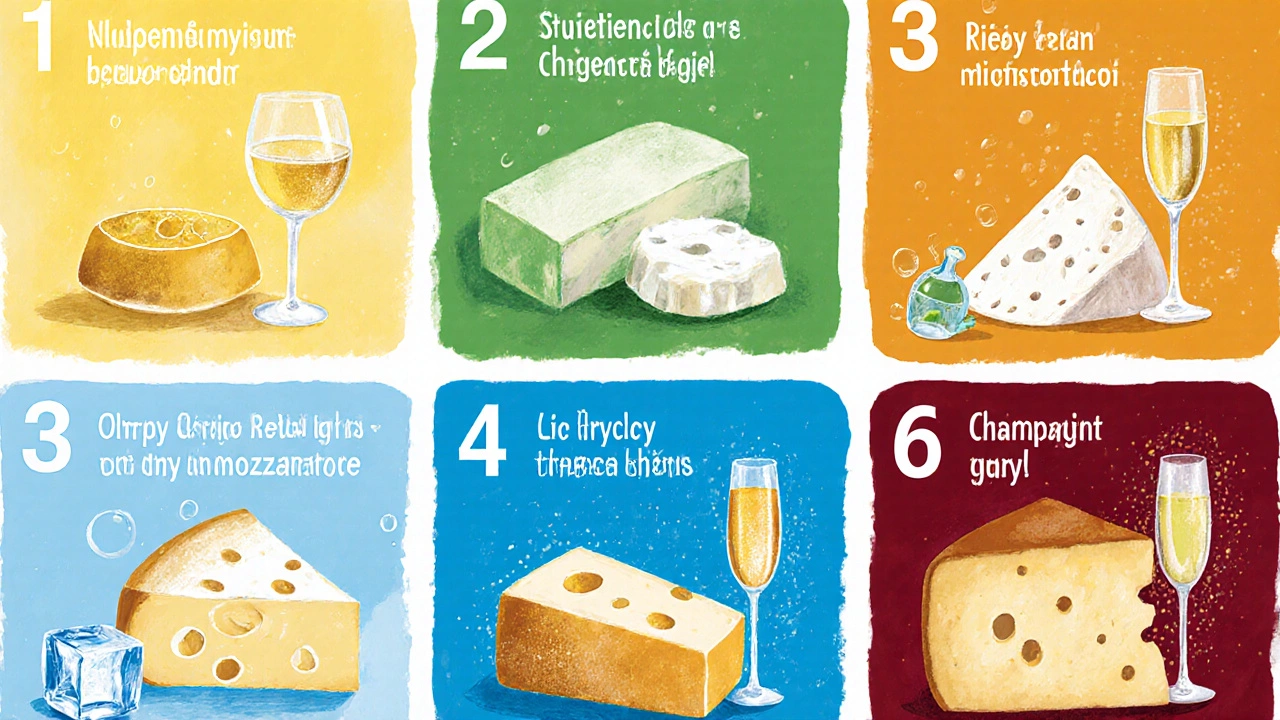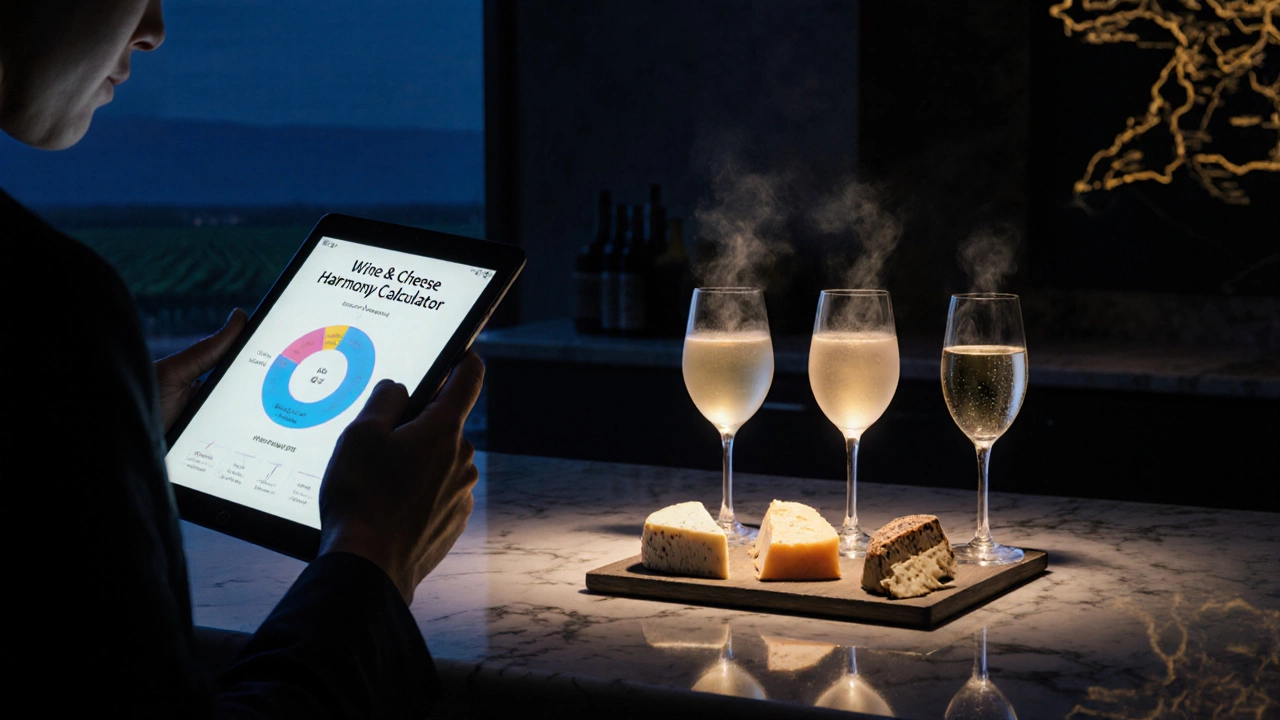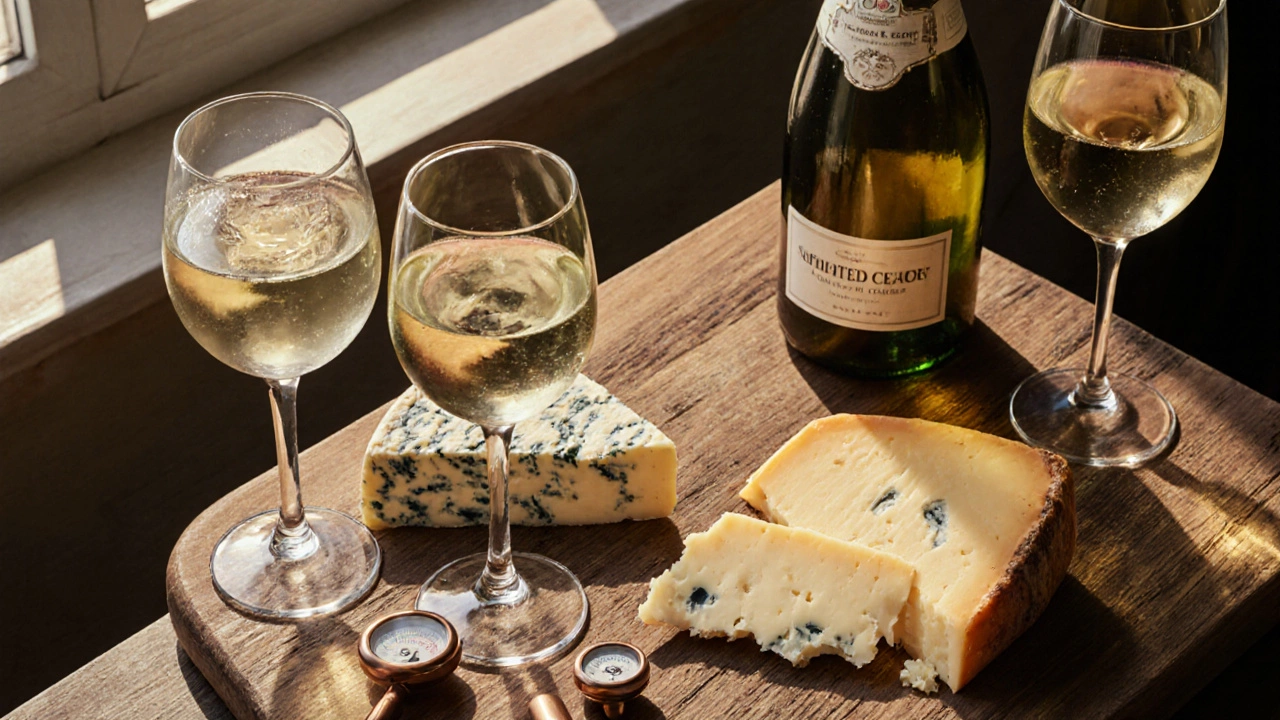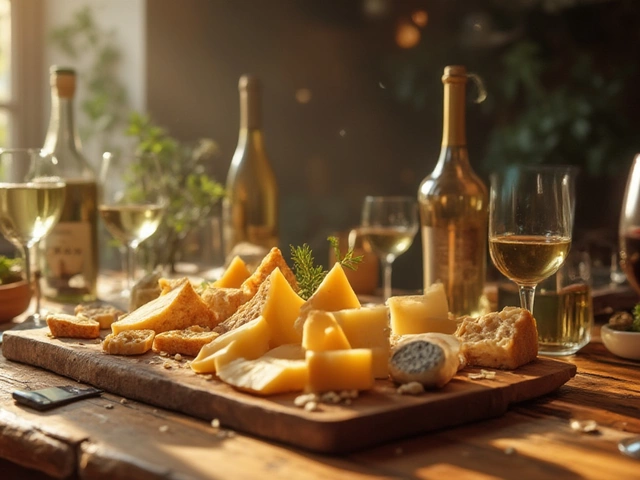White Wine & Cheese Pairing Calculator
Select Your Cheese
Results
Why This Works
Scientific principles will appear here based on your selections.
Choosing the right white wine for your cheese board can feel like a guessing game, but it doesn’t have to be. The goal is simple: find a wine that balances the fat, texture, and flavor of the cheese while highlighting the best bits of both.
Key Takeaways
- Acidity cuts through fat - pick high‑acid wines for creamy cheeses.
- Body matches intensity - light wines for fresh cheeses, fuller wines for aged, nutty varieties.
- Texture matters - soft cheeses need crisp wines; hard cheeses can handle richer, oak‑aged whites.
- Regional pairings often win - match wines and cheeses from the same area for a natural harmony.
- Serve at the right temperature: 45‑50°F for light whites, 55°F for oaked wines.
Why Chemistry Drives the Match
When you bite into a buttery triple‑cream, the fat coats your palate and dulls sharp flavors. A white wine is a low‑tannin, often high‑acid beverage that can cleanse that fatty film. The acidity (usually measured at pH 3.0‑3.4) lifts the cheese’s richness, while the wine’s alcohol helps dissolve flavor compounds trapped in the cheese’s protein matrix.
Conversely, a hard, aged cheese like Comté is a semi‑hard French cheese aged 18‑24 months with nutty, umami notes brings glutamates that echo the buttery, toasty aromas of a well‑aged Chardonnay. Matching these flavor wheels amplifies the experience.
Top White Wines and Their Ideal Cheese Partners
Below are the most versatile whites, why they work, and specific cheese matches that bring out their best.
Chardonnay is a medium‑to‑full‑bodied white wine, often undergoing malolactic fermentation that adds buttery diacetyl
- Rich, buttery cheeses: Triple‑cream cheeses like Mt Tam (75% butterfat) or butterkäse (30% butterfat) love the creamy mouthfeel of an unoaked Chardonnay (pH 3.2).
- Nutty, aged cheeses: 24‑month Comté or aged Gouda pair beautifully with the subtle oak‑derived vanilla in a lightly oaked Chardonnay (150‑200 mg/L vanillin).
- Avoid: pungent blues - the oak can clash with strong mold flavors, creating a metallic aftertaste.
Sauvignon Blanc is a high‑acid, herbaceous white wine with grassy pyrazine notes
- Goat cheeses: Fresh chèvre (45% moisture, caproic acid tang) is cut by the wine’s 7‑8 g/L acidity, highlighting the cheese’s bright, citrusy edge.
- Soft‑ripened cheeses: Brie or Camembert benefit from the wine’s crispness, which balances mushroom and buttery notes without overwhelming them.
- Tip: Serve at 45‑50°F to preserve the lively acidity.
Pinot Grigio is a light‑bodied white with moderate acidity (5‑6 g/L tartaric acid)
- Fresh mozzarella: Its high moisture (≈50%) and mild flavor are enhanced by Pinot Grigio’s clean finish.
- Young semi‑hard cheeses: Havarti or young Gouda (40‑50% moisture) pair nicely because the wine isn’t too heavy.
- Avoid: very aged cheeses (>12 months) - the wine may lack the body to stand up to strong caramel or nutty flavors.
Riesling is an aromatic white with acidity 8‑10 g/L and often a hint of residual sugar
- Sweaty, washed‑rind cheeses: Limburger or washed‑rind Gruyère love the sweet‑sour balance of an off‑dry Riesling (15‑45 g/L residual sugar).
- Sharp, salty cheeses: Pair with aged Cheddar (30‑35% fat) to soften the bite.
Champagne is a sparkling wine with 5‑6 atmospheres of pressure and bright acidity
- Triple‑cream cheeses: The bubbles physically break up the fat, making 75% butterfat cheeses feel lighter.
- Soft cheeses: Works well with young Camembert, adding a festive fizz.
Step‑by‑Step Decision Tree
- Identify the cheese category: fresh, soft‑ripened, semi‑hard, hard, or blue.
- Check the cheese’s fat percentage and moisture level.
- Match acidity: aim for 1 g/L acidity per 3‑4% fat (e.g., 30% butterfat → ~8‑10 g/L acidity).
- Choose body: light wine for fresh & soft cheeses, medium for semi‑hard, full‑bodied for aged or nutty cheeses.
- Consider regional affinity: if the cheese is from Sonoma, try a local Sonoma Sauvignon Blanc.
- Set temperature: 45°F for light whites, 55°F for oaked or fuller wines.
- Taste and adjust - a tiny drizzle of honey can bridge a slightly too‑dry wine.

Practical Serving Tips
- Keep wines chilled but not ice‑cold; a light white at 45°F stays crisp, while an oaked Chardonnay at 55°F shows its buttery depth.
- Let cheese sit at room temperature (65‑70°F) for 30 minutes before serving - this unlocks flavor.
- Avoid pairing oaked whites with young fresh cheeses; the oak can dominate delicate flavors.
- If a pairing feels heavy, add a splash of sparkling water to the glass to reset the palate.
Comparison Table: White Wines vs. Cheese Types
| Wine | Acidity (g/L) | Typical Body | Best Cheese Match |
|---|---|---|---|
| Chardonnay (unoaked) | 6‑7 | Medium‑full | Butterkäse, aged Gouda, Comté |
| Sauvignon Blanc | 7‑8 | Light‑medium | Goat chèvre, Brie, young Camembert |
| Pinot Grigio | 5‑6 | Light | Fresh mozzarella, young Havarti |
| Riesling (off‑dry) | 8‑10 | Medium | Limburger, aged Cheddar, blue cheeses |
| Champagne | 7‑8 | Light‑medium, sparkling | Triple‑cream, soft‑ripened cheeses |
Regional Pairings: When Waterways Match
Cheese and wine that share a watershed often click instantly. A Sonoma County Sauvignon Blanc paired with locally produced Laura Chenel's chèvre scored 4.7/5 in blind tastings, while the same wine with imported goat cheese only hit 3.9/5. The "what grows together goes together" rule is backed by chemistry: the soil minerals and micro‑flora influence both grape and milk flavors.

Emerging Tools & Trends
Tech is stepping into the tasting room. UC Davis’s Wine & Cheese Harmony Calculator an online tool that compares pH, acidity, and fat content to give a compatibility score is free to use and gives a quick 0‑100 rating. Apps like Cheese+ (launching Q2 2024) let you snap a photo of a cheese block; the AI suggests three white wines based on texture and flavor notes.
Another shift is toward low‑intervention natural wines paired with raw‑milk cheeses. Slow Food USA reported a 37% YoY growth in this niche, because the wild yeasts in natural wines echo the earthy microbes in raw cheeses.
Common Mistakes and How to Fix Them
- Too cold: Over‑chilling an oaked Chardonnay mutes its buttery flavors. Warm it up a few degrees.
- Mismatched intensity: Pairing a delicate Pinot Grigio with a strong, aged blue will leave the wine lost. Switch to a sweeter Riesling.
- Wrong texture match: Fresh cheeses need crisp acidity; if you reach for a heavy, oak‑rich wine, add a splash of sparkling water or a pinch of sea salt to rebalance.
Final Thoughts
There’s no single "best" white wine for all cheese. The sweet spot lies where acidity meets fat, body meets intensity, and regional character aligns. Use the decision tree, keep temperatures right, and trust your palate. When science and personal taste meet, every bite and sip becomes a tiny celebration.
What is the most important factor when pairing white wine with cheese?
Acidity is the key. It cuts through the fat in creamy cheeses and brightens the palate, letting the wine’s flavors shine.
Can I pair sparkling wine with hard cheeses?
Yes, especially if the sparkling wine has enough body, like a vintage Champagne. It pairs well with aged Gouda or 24‑month Comté.
Do I need to refrigerate white wine before serving?
Light, high‑acid wines should be chilled to 45‑50°F. Fuller, oaked whites taste better at about 55°F, so pull them out of the fridge a few minutes early.
What white wine goes best with blue cheese?
A sweet Riesling or Sauternes balances the salty, pungent bite of blue cheese. The residual sugar softens the sharpness.
How do I know if a wine is too oaked for my cheese?
If the cheese is fresh or lightly ripened (like chèvre or Brie), the oak can overwhelm. Stick to unoaked or lightly oaked wines for those.


